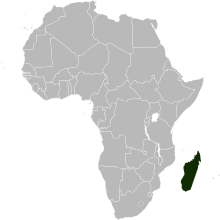
Back Madagaskarplan Afrikaans خطة مدغشقر Arabic Madaqaskar planı Azerbaijani Мадагаскарски план Bulgarian মাদাগাস্কার প্ল্যান Bengali/Bangla Pla Madagascar Catalan Plán Madagaskar Czech Madagaskarplanen Danish Madagaskarplan German Σχέδιο Μαδαγασκάρη Greek

The Madagascar Plan (German: Madagaskarplan) was a plan proposed by the Nazi German government to forcibly relocate the Jewish population of Europe to the island of Madagascar. Franz Rademacher, head of the Jewish Department of the German Foreign Office, proposed the idea in June 1940, shortly before the Fall of France. The proposal called for the handing over of control of Madagascar, then a French colony, to Germany as part of the eventual peace terms.
The idea of re-settling Polish Jews to Madagascar was investigated by the French Third Republic and the Second Polish Republic in 1937,[1][2] but the task force sent to evaluate the island's potential determined that only 5,000 to 7,000 families could be accommodated, or even as few as 500 families by some estimates.[a] As the efforts by the Nazis to encourage the emigration of the Jewish population of Germany before World War II were only partially successful, the idea of deporting Jews to Madagascar was revived by the Nazi government in 1940.
Rademacher recommended on 3 June 1940 that Madagascar should be made available as a destination for the Jews of Europe. With Adolf Hitler's approval, Adolf Eichmann released a memorandum on 15 August 1940 calling for the resettlement of a million Jews per year for four years, with the island being governed as a police state under the SS. They assumed that many Jews would succumb to its harsh conditions should the plan be implemented.[5] The plan was not viable when proposed due to the British naval blockade. It was postponed after the Nazis lost the Battle of Britain in September 1940, and it was permanently shelved in 1942 with the commencement of the Final Solution, the policy of systematic genocide of Jews, towards which it had functioned as an important psychological step.[6]
- ^ Browning 2004, p. 82.
- ^ Nicosia 2008, p. 280.
- ^ "World Population Prospects 2022". United Nations Department of Economic and Social Affairs, Population Division. Retrieved 17 July 2022.
- ^ "World Population Prospects 2022: Demographic indicators by region, subregion and country, annually for 1950-2100" (XSLX) ("Total Population, as of 1 July (thousands)"). United Nations Department of Economic and Social Affairs, Population Division. Retrieved 17 July 2022.
- ^ Longerich 2010, p. 162.
- ^ Browning 1995, pp. 18–19, 127–128.
Cite error: There are <ref group=lower-alpha> tags or {{efn}} templates on this page, but the references will not show without a {{reflist|group=lower-alpha}} template or {{notelist}} template (see the help page).